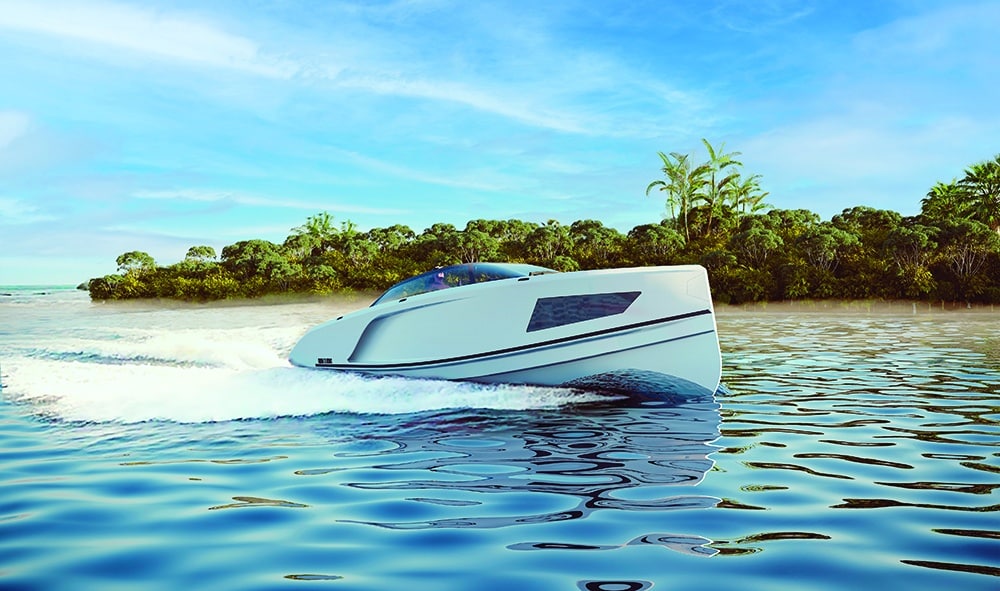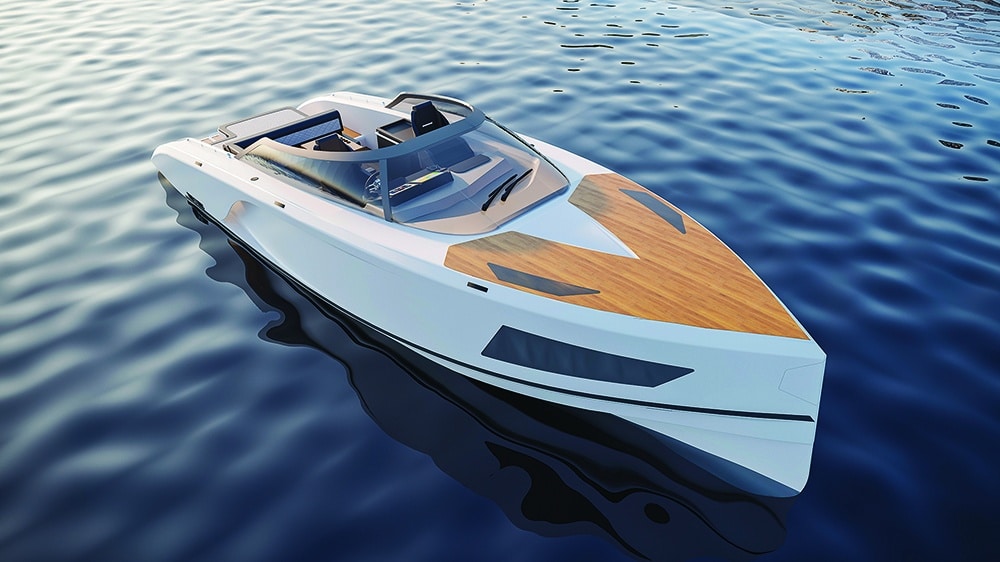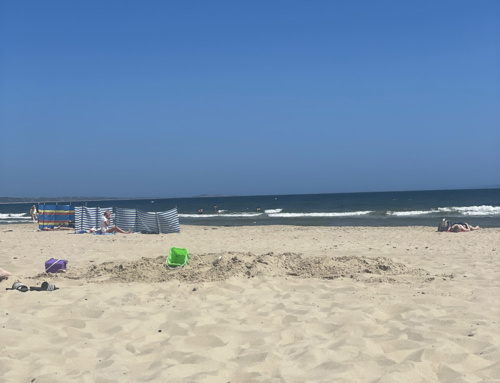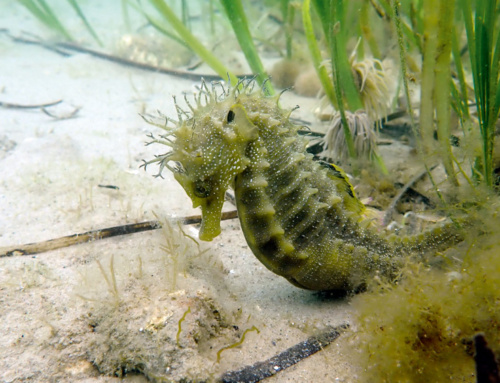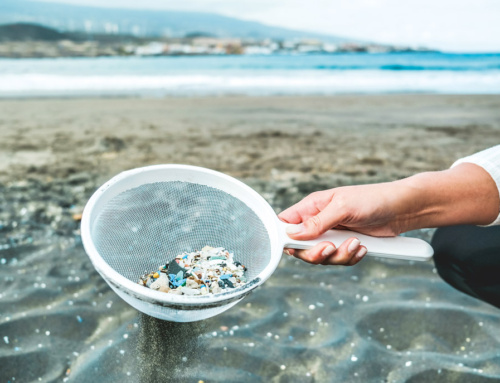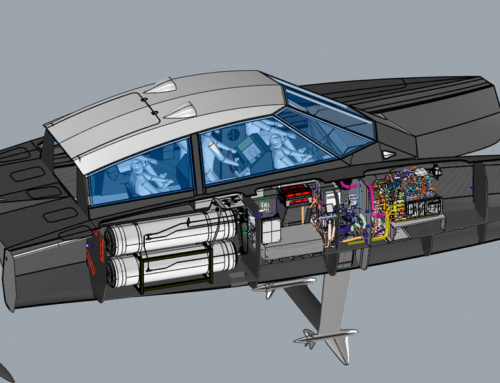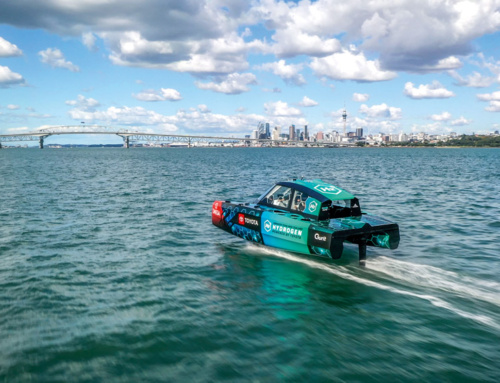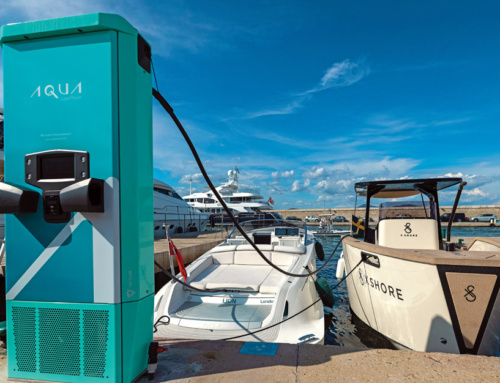A British-built hybrid cruiser that aims to make offshore electric powerboating a reality.
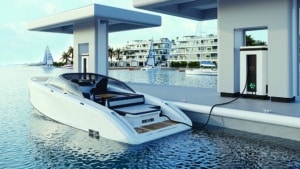
Fast dockside charging is already under discussion with MDL.
In light of the current increasing anti-fossil fuel sentiment, the marine industry is at last starting to mimic the automotive world. However, in the boating universe, this ‘go green’ sentiment tends to be ahead of reality. In real terms, electric planing powerboats, constrained by limited power reserves, are not seen as stand-alone craft in their own right. This might now be about to change, as a new British company, following extensive periods of R&D, has a concept on its books that could make green powerboating a reality.
Is this really the holy grail of electric boating, in terms of being able to do 30 knots for 150 miles or more on a battery? The answer to that is no, and I doubt that many of us will truly see that level of technology in our lifetimes. Nevertheless, it is a big step in the right direction, and in terms of green credibility, Furyan’s new F35 is a serious contender. This company has combined cutting-edge technology with a powerful electric stern-driven engine, supplied by two substantial lithium battery banks. To make this a realistic concept, a ‘hybrid range extender’ is used. That may not make this a true all-electric boat, but what it means is that you will not be left dead in the water waiting to be another RNLI statistic.
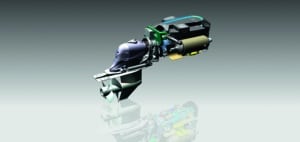
The Konrad sterndrive is the only transmission capable of dealing with 400kW of torque. Considering its 536hp output equivalent, this is a compact engine.
The main power plant comprises two inline ‘cascade’ 200kW electric motors, supported by a rotary engine 120hp diesel generator, otherwise known as the ‘range extender’. The reason behind two electric motors is that it enables greater power delivery efficiency. Simply put, if only 180kW of power is needed, then only one engine will run at 90%, which is more efficient than running one large 400kW engine at 45%. When the power demand exceeds 200kW, the second engine will seamlessly come into play, hence the ‘cascade’ terminology. If one engine should fail, the other can still run, and having a cascading power delivery means that the power delivery is ‘phased in’ to match the power curve of the propeller. The energy for these motors comes from four 63kWh lithium battery banks, which weigh 380kg each and cost £108,000 in total. This is a big chunk of weight in lieu of a fuel tank, but it is located just aft of amidships. The cascade motors and range extender weigh just 187kg, considerably lighter than a 530hp diesel engine – which is the fossil fuel equivalent of 400kW of electric power. The cascades are axial flux electric motors, which by their nature have a maximum engine speed of 3500rpm – considerably lower than other electric power plants. The advantage here is that this makes them perfectly suited, with a 1.5:1 ratio, to drive through the 680 Konrad twin-prop sterndrive. The Konrad, which is better known in the commercial sector, is a heavy-duty sterndrive and, with little doubt, the only system capable of handling the extreme levels of low-speed torque produced by a powerful electric motor.
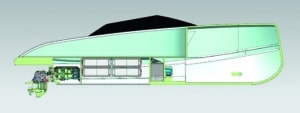
The bulk of the battery weight sits amidships.
Battery and motor efficiency are crucial factors in squeezing every drop of green juice from this system. Temperature is a key component in this area. Consequently, the batteries are cooled by a dielectric coolant, which in cold weather can be preheated through a heat exchanger in the range extender exhaust system to get them up to 18°C – their most power-efficient temperature. The motors are cooled by a special light oil that runs through a seawater heat exchanger, and the range extender uses a conventional glycol-based heat exchanger cooling system.
How this energy is actually harnessed is also a key ingredient in this boat’s efficiency. The Furyan uses an advanced engine management control system (EMCS), which takes into account a wide selection of factors. The EMCS also encompasses GPS, weather and tides, so when you plot a course it knows how far, the sea state and the tidal rate/direction. As a result, it will know how much charging output the range extender needs to provide for your passage, if at all. Obviously, speed over ground has a bearing on this too, which is where the three system settings of Eco, Cruise and Sport come in. If you run in Sport mode, the range extender will be cutting in and out to compensate for your power demands – as and when. In Cruise mode, the management system will calculate a constant demand, and the range extender will run/not run accordingly. Eco mode covers a spectrum of displacement and semi-displacement speeds where power needs are very low, and the extender will top up as and when. At 12 knots, the Furyan can run on the 90kW maximum output provided by the range extender, whose fuel tank has a maximum range of 150nm at this speed. Below 12 knots there is a charging surplus that is fed into the battery bank, and given that the extender is more efficient at 66% power output, running at 9 or 10 knots will give this boat a substantial range increase.
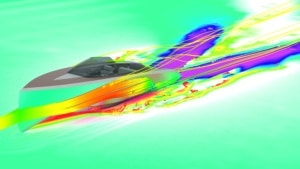
Extensive CFD has gone into the hull’s design.
The wave-piercing hull design is the product of extensive computational fluid dynamics (CFD) and has been designed in collaboration with Petestep from Sweden. One important aspect of this hull is that the forward wave-piercing section has been designed with a strong focus on displacement and semi-displacement efficiency. Petestep hulls have been featured in previous issues of PBR, and Furyan will be using a hull based on the same concept. This design channels water aft, directly under the hull towards the transom, as otherwise it is considered lost energy. The V-shaped steps that comprise the Petestep are raked aft from a point on the keel line at the bottom of the forefoot. They are shallow and unobtrusive and only easily visible when the boat is planing. They are subtle enough not to adversely increase the level of disturbed water leaving the transom, but sufficient to direct the water flow aft rather than sideways. Apart from a drier ride, this is claimed to improve efficiency due to increased hydrodynamic lift; indeed, previous sea trials have indicated this gain to be around 5%.
The boat will be manufactured using bio resin flax fibre for the hull, deck and internal liners. Flax is a natural fibre that can be recycled and has a very low CO2 manufacturing ratio compared to conventional construction methods. Furyan state that they will be able to achieve a very high strength-to-weight ratio.
There is, of course, that inevitable question of recharging. At the moment this will be available in three forms: a 360kW fast-charging system available at a marina fuelling pontoon, which will recharge a fully discharged battery in one hour; a pontoon charging wall box that can recharge overnight; and a portable charger that can provide a top-up charge of 22kW or a 24-hour trickle charge from zero to full capacity. Following Furyan’s talks with MDL Marinas, a fast-charging system is in the pipeline. The cost at the moment has been calculated at 16p per kilowatt, which put in a very rough perspective means that running the Furyan F35 will cost about 60% of a comparable diesel boat.
The price of the Furyan is estimated at £475,000 (plus VAT), with delivery in 2022.
Specifications
- LOA: 10.66m (35ft 0in)
- Beam: 3.27m (10ft 7in)
- Draught: 0.75m (2ft 4in)
- Range extender fuel capacity: 220L (50 gal)
- Water capacity: 220L (50 gal)
- Black-water capacity: 90L (20 gal)
- Engines: 2 x 200kW (536hp total) axial flux electric motors inline
- Battery capacity: 252kWh
- Performance: 38 knots
- Performance cruising: 25 knots
- Range pure electric: 32nm at 25 knots
- Range hybrid: 57nm at 38 knots, 58nm at 25 knots, 150nm at 12 knots
- CE rating: C for 8
Contact www.furyanmarinetechnology.com

